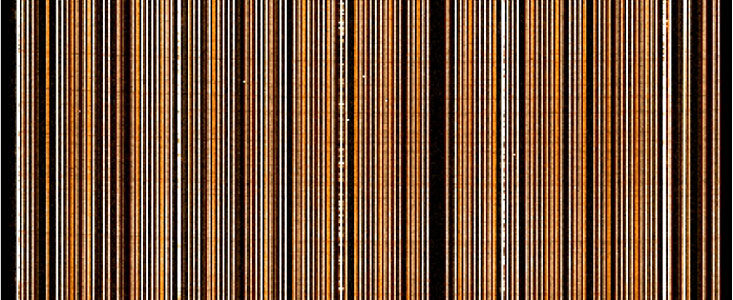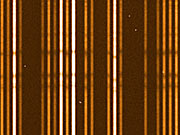Persbericht
GIRAFFE Reaches towards the Stars
"First Light" of New Powerful Spectrograph at the VLT
8 juli 2002
The first observations of stellar spectra have just been performed with the new GIRAFFE multi-object spectrograph on the ESO Very Large Telescope (VLT) at the Paranal Observatory in Chile. This milestone event was achieved in the early morning of July 3, 2002. It signifies another important step towards the full implementation of the extremely powerful Fibre Large Array Multi-Element Spectrograph (FLAMES), one of the main instruments for the ESO VLT. This project is co-ordinated by ESO and incorporates many complex components that have been constructed at various research institutions in Europe and Australia. The GIRAFFE spectrograph provides unique possibilities for detailed observations of the properties of individual stars located in our Milky Way galaxy ( PR 16b/02 ) as well as in other galaxies of the Local Group.
FLAMES and GIRAFFE
The multi-object GIRAFFE spectrograph, now installed on the 8.2-m KUEYEN Unit Telescope of ESO's Very Large Telescope (VLT) at the Paranal Observatory (Chile), achieved "First Light" in the early morning hours of July 3, 2002.
This complex instrument allows to obtain high-quality spectra of a large variety of celestial objects, from individual stars in the Milky Way and other nearby galaxies, to very distant galaxies. It functions by means of multiple optical fibres that guide the light from the telescope's focal plane into the entry slit of the spectrograph. Here the light is dispersed into its different colours.
Anticipating already at this early moment the future, highly effective operation of the new facility, the first data were immediately prepared for astronomical interpretation ("reduced") by means of a dedicated software package ("pipeline").
GIRAFFE and these fibres are an integral part of the advanced Fibre Large Array Multi-Element Spectrograph (FLAMES) facility which also includes the OzPoz positioner and an optical field corrector . It is the outcome of a collaboration between ESO, Observatoire de Paris-Meudon Observatoire de Genève-Lausanne and the Anglo Australian Observatory (AAO).
The principle of this instrument involves the positioning in the telescope's focal plane of a large number of optical fibres. This is done in such a way that each of them guides the light from one particular celestial object towards the spectrograph that records the spectra of all these objects simultaneously.
The size of the available field-of-view is no less than about 25 arcmin across, i.e. almost as large as the full moon. The individual fibres are moved and positioned "on the objects" in the field by means of the OzPoz positioner.
Different observational modes
FLAMES has several different modes of operation. Two of these are of the simple "multi-object" type: each fibre collects the light from one star or galaxy - up to 132 objects can be observed simultaneously, cf. ESO Press Release eso0225 . In this respect, GIRAFFE provides absolutely unique possibilities for detailed observations of the properties (age, chemical composition, rotation and space velocity) of individual stars located in the main disk, central bulge or halo of our Milky Way galaxy (ESO Press Release eso0225), and also of stars in other galaxies of the Local Group.
Another observational mode is known as "3-D spectroscopy" or "integrated field". This consists of obtaining simultaneous spectra of smaller areas of extended objects like galaxies or nebulae. For this, 15 deployable fibre bundles, the so-called Integral Field Units (IFUs), cf. ESO Press Release eso0203, are used. Each IFU is a microscopic, state-of-the-art two-dimensional lens array with an aperture of 3 x 2 arcsec 2 on the sky. It is like an insect's eye, with twenty micro-lenses coupled with optical fibres leading the light recorded at each point in the field to the entry slit of the spectrograph.
Unique research opportunities opening
The FLAMES facility, once in full operation after further testing and fine-tuning later this year, will enormously increase the possibilities to study stellar physics and the evolution of galaxies, two of the cornerstones in our understanding of the structure and evolution of the Universe.
With the great light-gathering capacity of the VLT, FLAMES will be able to gather very comprehensive information about even rather faint objects, enabling the astronomers to study them in a degree of detail so far reserved for brighter, nearby stars.
The quality of the first spectra from GIRAFFE, although far from exploiting the ultimate potential of the new facility, fully confirm these expectations.
Noten
[1] This is a joint Press Release of ESO and the Observatoire de Paris.
Contact
François Hammer
Observatoire de Paris-Meudon
Paris, France
Tel: +33 1 45 07 74 08
E-mail: francois.hammer@obspm.fr
Luca Pasquini
ESO
Garching, Germany
Tel: +4989-3200-6792
E-mail: lpasquin@eso.org
Over dit bericht
| Persberichten nr.: | eso0219 |
| Legacy ID: | PR 13/02 |
| Naam: | First Light, Instrumentation, Spectrum |
| Type: | Milky Way : Galaxy |
| Facility: | Very Large Telescope |
| Instruments: | FLAMES |
Our use of Cookies
We use cookies that are essential for accessing our websites and using our services. We also use cookies to analyse, measure and improve our websites’ performance, to enable content sharing via social media and to display media content hosted on third-party platforms.
ESO Cookies Policy
The European Organisation for Astronomical Research in the Southern Hemisphere (ESO) is the pre-eminent intergovernmental science and technology organisation in astronomy. It carries out an ambitious programme focused on the design, construction and operation of powerful ground-based observing facilities for astronomy.
This Cookies Policy is intended to provide clarity by outlining the cookies used on the ESO public websites, their functions, the options you have for controlling them, and the ways you can contact us for additional details.
What are cookies?
Cookies are small pieces of data stored on your device by websites you visit. They serve various purposes, such as remembering login credentials and preferences and enhance your browsing experience.
Categories of cookies we use
Essential cookies (always active): These cookies are strictly necessary for the proper functioning of our website. Without these cookies, the website cannot operate correctly, and certain services, such as logging in or accessing secure areas, may not be available; because they are essential for the website’s operation, they cannot be disabled.
Functional Cookies: These cookies enhance your browsing experience by enabling additional features and personalization, such as remembering your preferences and settings. While not strictly necessary for the website to function, they improve usability and convenience; these cookies are only placed if you provide your consent.
Analytics cookies: These cookies collect information about how visitors interact with our website, such as which pages are visited most often and how users navigate the site. This data helps us improve website performance, optimize content, and enhance the user experience; these cookies are only placed if you provide your consent. We use the following analytics cookies.
Matomo Cookies:
This website uses Matomo (formerly Piwik), an open source software which enables the statistical analysis of website visits. Matomo uses cookies (text files) which are saved on your computer and which allow us to analyze how you use our website. The website user information generated by the cookies will only be saved on the servers of our IT Department. We use this information to analyze www.eso.org visits and to prepare reports on website activities. These data will not be disclosed to third parties.
On behalf of ESO, Matomo will use this information for the purpose of evaluating your use of the website, compiling reports on website activity and providing other services relating to website activity and internet usage.
Matomo cookies settings:
Additional Third-party cookies on ESO websites: some of our pages display content from external providers, e.g. YouTube.
Such third-party services are outside of ESO control and may, at any time, change their terms of service, use of cookies, etc.
YouTube: Some videos on the ESO website are embedded from ESO’s official YouTube channel. We have enabled YouTube’s privacy-enhanced mode, meaning that no cookies are set unless the user actively clicks on the video to play it. Additionally, in this mode, YouTube does not store any personally identifiable cookie data for embedded video playbacks. For more details, please refer to YouTube’s embedding videos information page.
Cookies can also be classified based on the following elements.
Regarding the domain, there are:
- First-party cookies, set by the website you are currently visiting. They are stored by the same domain that you are browsing and are used to enhance your experience on that site;
- Third-party cookies, set by a domain other than the one you are currently visiting.
As for their duration, cookies can be:
- Browser-session cookies, which are deleted when the user closes the browser;
- Stored cookies, which stay on the user's device for a predetermined period of time.
How to manage cookies
Cookie settings: You can modify your cookie choices for the ESO webpages at any time by clicking on the link Cookie settings at the bottom of any page.
In your browser: If you wish to delete cookies or instruct your browser to delete or block cookies by default, please visit the help pages of your browser:
Please be aware that if you delete or decline cookies, certain functionalities of our website may be not be available and your browsing experience may be affected.
You can set most browsers to prevent any cookies being placed on your device, but you may then have to manually adjust some preferences every time you visit a site/page. And some services and functionalities may not work properly at all (e.g. profile logging-in, shop check out).
Updates to the ESO Cookies Policy
The ESO Cookies Policy may be subject to future updates, which will be made available on this page.
Additional information
For any queries related to cookies, please contact: pdprATesoDOTorg.
As ESO public webpages are managed by our Department of Communication, your questions will be dealt with the support of the said Department.


